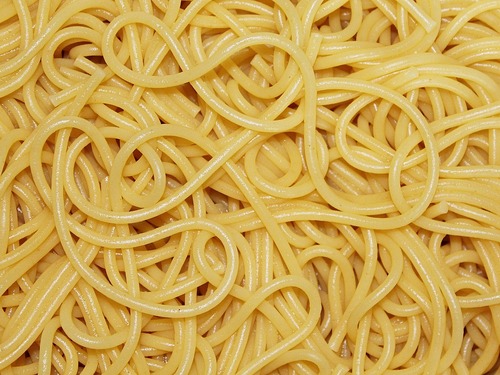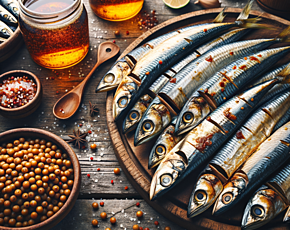Short answer
Pasta isn't bad for you when consumed in moderation as part of a balanced diet. Regular, whole wheat, and high-protein or high-fiber pastas have low to moderate glycemic indices and can be part of a healthy eating pattern, especially when paired with nutrient-rich foods. Gluten-free options might have higher glycemic indices. Mindful portion sizes and preparation methods can maximize pasta's health benefits, whereas overconsumption, particularly of refined types, can lead to weight gain and affect blood sugar levels.
Recommended Alternative
Long answer
Glycemic Index of Different Types of Pasta
The glycemic index (GI) is a ranking system for carbohydrates based on their immediate effect on blood glucose (sugar) levels. It compares foods by how much they raise blood sugar levels compared to a standard reference food. The scale ranges from 0 to 100, with lower values indicating a slower release of sugar into the bloodstream. Understanding the GI of different types of pasta can help manage dietary choices, especially for those concerned with blood sugar management, such as individuals with diabetes.
Regular Wheat Pasta
Most traditional pastas made from refined wheat have a moderate glycemic index. According to the University of Sydney's Glycemic Index Database, regular white pasta typically has a GI in the range of 45-50. This places it in the low to medium GI category, which is somewhat surprising given its refined carbohydrate content. The lower GI can be attributed to the physical entrapment of ungelatinized starch granules in a matrix of protein (gluten) within the pasta, which makes it harder for digestive enzymes to reach the starch.
Whole Wheat Pasta
Whole wheat pasta, which includes more of the natural grains, has a similar GI to that of regular pasta, typically in the range of 40-50. The inclusion of wheat bran may slow the digestion process slightly, leading to a more gradual rise in blood sugar levels.
High-Protein and High-Fiber Pasta
Pasta varieties that are fortified with protein or additional fiber can have a lower glycemic index. The added protein and fiber may slow carbohydrate digestion and sugar absorption. Examples include pasta made with legumes like chickpeas or lentils, which tend to have a significantly lower GI, around 32.
Gluten-Free Pasta
Gluten-free pasta, made from a variety of alternative grains such as rice, corn, quinoa, or a blend of these, generally has a higher glycemic index compared to regular pasta. The GI of gluten-free pasta varies widely depending on the ingredients used but often falls within a range of 55-70.
Factors Influencing GI of Pasta
Several factors can affect the glycemic index of the pasta you eat. These include:
- Processing: The level of processing can impact the GI. More processed pasta tends to have a higher GI.
- Ingredients: The type of flour used and the presence of additional fibers or proteins are also influential.
- Cooking Time: Al dente pasta, which is cooked to be firm, has a lower GI than pasta that is cooked longer until it's soft.
- Cooling: Once pasta is cooked and then cooled, it can develop resistant starches, which decrease the GI.
The table below summarizes average GI values for commonly consumed pasta types. Keep in mind, these values are approximate and can vary based on brand, preparation, and accompaniments.
| Type of Pasta | Glycemic Index (Average) |
|---|---|
| Regular White Pasta | 45-50 |
| Whole Wheat Pasta | 40-50 |
| Chickpea/Lentil Pasta | 32 |
| Gluten-Free Pasta | 55-70 |
It's important to note that the GI gives an indication of how quickly a carbohydrate-containing food affects blood glucose levels, but it does not consider the quantity consumed. The glycemic load (GL) is also a useful measure as it takes into account the carbohydrate content in a serving of food, providing a more complete picture of its potential impact on blood sugar management.
Refined vs. Whole Grain Pasta Nutritional Differences
The debate between refined and whole grain pasta is rooted in their nutritional profiles, which differ significantly. Understanding these differences is key to making informed dietary choices that align with your health goals. Let's break down the main nutritional distinctions between these two types of pasta.
Fiber Content: Whole grain pasta is a standout option when it comes to fiber. An average serving of whole wheat spaghetti boasts around 6 grams of fiber, while its refined counterpart typically offers a mere 2.5 grams. Dietary fiber is crucial for digestive health and can help maintain a healthy weight.
Vitamins and Minerals: In whole grain pasta, the nutrient-rich bran and germ layers are preserved, providing a wealth of B-vitamins, such as thiamine, riboflavin, niacin, and folate. It also offers minerals like iron, magnesium, and selenium. In contrast, refined pasta, stripped of these layers, has lower levels of these nutrients and often requires enrichment to replace lost vitamins and minerals.
Glycemic Index (GI): The glycemic index, which measures how quickly carbohydrates are digested and raise blood sugar levels, is typically lower in whole grain pasta (around 45-50) compared to refined pasta (around 55-65). A lower GI can contribute to better blood sugar control and prolonged energy release.
Protein Quality: While the protein content doesn't vary drastically, whole grain pasta comes out slightly ahead. More importantly, the quality of protein is better in whole grains due to the presence of more varied amino acids that come with the grain's natural composition.
Antioxidant Levels: Whole grains are a good source of antioxidants such as phytic acid, ferulic acid, and lignans, which may help combat oxidative stress. These compounds are significantly reduced in refined pastas due to the removal of the grain's outer layers during processing.
Caloric Density: There's a common misconception that whole grain pasta is much lower in calories. In reality, the calorie count is similar, but the higher fiber content in whole grain pasta can help with satiety, potentially reducing overall calorie consumption.
Here's a comparative table highlighting these nutritional differences:
| Nutrient | Whole Grain Pasta (per 100g cooked) | Refined Pasta (per 100g cooked) |
|---|---|---|
| Fiber | 6g | 2.5g |
| B-Vitamins | Higher quantity, full spectrum | Lower quantity, often enriched |
| Minerals | Rich in iron, magnesium, selenium | Fewer natural minerals, often enriched |
| Glycemic Index | 45-50 | 55-65 |
| Protein | Slightly higher, better quality | Slightly lower |
| Antioxidants | Higher levels | Lower levels |
| Calories | Similar to refined pasta | Similar to whole grain pasta |
Experts from The American Heart Association and the Whole Grains Council recommend whole grains as part of a healthy diet, citing the comprehensive benefits of these nutrients. While both types of pasta can have their place in a balanced diet, whole grain pasta offers a more complex nutritional profile that can contribute to long-term health benefits.
Gluten Content in Pasta and Its Effects
For many, pasta is a convenient and comforting staple in their diet, but when considering its health impact, one cannot overlook the role of gluten. Gluten is a mixture of proteins found in wheat and related grains, such as barley and rye, and it is present in most traditional pasta. It gives pasta its characteristic elasticity and chewiness. However, gluten can have varying effects on individuals, which fall into three categories:
- Celiac Disease: This is an autoimmune disorder where the ingestion of gluten leads to damage in the small intestine. For people with celiac disease, consuming gluten triggers an immune response that damages the lining of the small intestine. This can lead to malabsorption of nutrients and various other complications. Gluten-containing pasta is particularly detrimental for these individuals.
- Non-Celiac Gluten Sensitivity: Some people may experience symptoms similar to those of celiac disease, including bloating, headaches, or fatigue, yet they test negative for celiac disease. Consuming gluten-containing pasta might provoke these symptoms in sensitive individuals.
- Wheat Allergy: A wheat allergy is a reaction to proteins found in wheat, with gluten being a potential allergen. Symptoms can range from mild (such as hives or digestive discomfort) to severe (such as anaphylaxis). Avoiding gluten-containing pasta is necessary for those with a wheat allergy.
For the majority of the population who do not have celiac disease, a non-celiac gluten sensitivity, or a wheat allergy, eating pasta with gluten is unlikely to cause health issues. In fact, whole wheat pasta can be a part of a healthy diet, as it provides fiber, vitamins, and minerals. However, overconsumption of pasta, particularly refined pasta, can contribute to weight gain and may affect blood sugar levels.
The gluten content of pasta can vary depending on the type of wheat used and the processing methods. According to research published in The American Journal of Clinical Nutrition, the average gluten content in pasta can range from 5.5% to 11.7%.
| Type of Pasta | Approximate Gluten Content |
|---|---|
| Traditional wheat pasta | 10-12% |
| Whole wheat pasta | 11-13% |
| Gluten-free pasta (rice, corn, quinoa) | 0% |
To accommodate the growing demand for gluten-free options, food manufacturers have developed various gluten-free pasta alternatives. These are made with grains and legumes that do not contain gluten, such as rice, corn, quinoa, and lentils. While gluten-free pasta can be a healthful choice, it is essential to examine the nutritional information as some may be higher in calories or lower in fiber compared to their whole wheat counterparts.
It's important to note that gluten alone is not inherently 'bad' for the health of most individuals; however, one's health conditions, dietary needs, and overall consumption patterns heavily influence the suitability of gluten-containing pasta in their diet. Consulting with a healthcare provider or a registered dietitian can offer personalized advice on gluten intake and pasta consumption based on individual health needs.
Pasta's Role in Weight Management and Obesity
When considering the role of pasta in weight management and obesity, it is essential to examine the scientific evidence and understand how this popular food fits into a balanced diet. While pasta is often categorized as a high-carbohydrate food, which could imply risk for weight gain, recent research suggests that the relationship between pasta consumption and obesity is not so straightforward.
A study published in the journal BMJ Open followed participants on a Mediterranean diet, including pasta, and concluded that pasta consumption was negatively associated with body mass index (BMI), waist circumference, and waist-to-hip ratio. This indicates that, within the context of a healthy diet, pasta may not contribute to weight gain or obesity.
Pasta’s Glycemic Index (GI)
One factor to consider is the glycemic index of pasta. The GI measures how quickly a food increases blood sugar levels. Despite being a carbohydrate-rich food, pasta has a relatively low GI due to the way its starches are bound, which means that it releases sugars into the bloodstream at a slower rate. This slow release can help with satiety and potentially aid in weight management by reducing the likelihood of overeating.
Pasta Portions and Weight Management
Portion size plays a crucial role in weight management. A reasonable serving of pasta, according to dietary guidelines, is about 1/2 cup of cooked pasta. Overindulging in large pasta servings, especially when combined with high-calorie sauces and toppings, can contribute to a caloric surplus and subsequent weight gain. Mindful portion control is, therefore, key in including pasta in a diet without adversely impacting weight.
The Type of Pasta Matters
The nutritional quality of pasta varies depending on the type. Whole grain pasta, for example, is made from the entire grain kernel, retaining more fiber and nutrients than refined pasta made from milled wheat. The increased fiber content in whole grain pasta contributes to feelings of fullness, which may help with lower caloric intake and weight control. Furthermore, the substitution of traditional pasta with legume-based or alternative grain pastas can offer higher protein content, additional fiber, and a distinct nutritional profile that may be more conducive to weight management goals.
Role of Pasta in a Balanced Diet
Integrating pasta into a balanced diet requires attention to what accompanies it on the plate. A health-conscious approach would include pairing pasta with lean proteins, a plethora of vegetables, and healthy fats while limiting high-sugar or high-fat sauces and ingredients. This balanced approach can mitigate the potential for weight gain and support the inclusion of pasta as part of a varied and nutritious diet.
Conclusion from Nutrition Experts
Nutrition experts often emphasize that no single food is inherently "bad" for weight management, including pasta. The main issue arises from how pasta is consumed—portion sizes, preparation methods, and the frequency with which it is eaten. When pasta is enjoyed responsibly as part of a diverse and balanced diet, it does not need to be completely eliminated from a weight-conscious meal plan.
Understanding the complexity of pasta and its effects on weight management requires a nuanced, evidence-based perspective. Individuals concerned about weight and health should focus on the entire dietary pattern, physical activity levels, and lifestyle factors when making dietary decisions, rather than singling out specific foods like pasta.
Balancing Pasta Intake Within a Diverse Diet
The consumption of pasta, like any other food, must be approached with balance and consideration within the context of an entire diet. A diverse diet that provides a range of nutrients is crucial for maintaining optimal health. Here are some aspects to consider when incorporating pasta into your diet:
- Whole Grains vs. Refined Grains: Opting for whole-grain pasta can have a significant impact on its health effects. Whole grains are richer in fiber, vitamins, minerals, and antioxidants compared to refined grains. According to a study published in the Journal of Nutrition, higher whole grain intake is associated with a lower risk of cardiovascular disease, type 2 diabetes, and obesity.
- Portion Size: Moderation is key. The Dietary Guidelines for Americans suggest that grains, whole or refined, should make up about one-quarter of your plate. This recommendation guides you to consume pasta as part of a meal rather than the central focus, helping to keep calorie intake in check.
- Preparation Matters: How you prepare your pasta dish can drastically alter its nutritional profile. Using fresh vegetables, lean proteins, and avoiding heavy, cream-based sauces can contribute to a more balanced meal. Instead, opt for tomato-based sauces and incorporate a variety of vegetables to increase the dish's fiber and nutrient density.
- Glycemic Index: Pasta has a relatively low glycemic index (GI) compared to other refined grain products, which implies that it causes a lower and slower rise in blood glucose levels. Low-GI diets are beneficial for blood sugar control, particularly for individuals with diabetes. Nevertheless, the quantity and the accompaniments can affect the overall GI of a meal.
- Dietary Needs and Restrictions: For those with gluten sensitivity or celiac disease, regular pasta can cause adverse health reactions. Fortunately, there are gluten-free pasta options available that are made from alternative grains, such as rice, corn, or quinoa. Even for those without gluten issues, these alternatives can offer a variation in nutrient intake.
- Complementing with Protein and Fiber: Including a good source of protein with your pasta, such as chicken, fish, legumes, or tofu, can help balance blood sugar levels and increase satiety. Similarly, adding fiber-rich vegetables will contribute to fullness and help manage the overall calorie content of the meal.
- Frequency of Consumption: Variety in your diet is beneficial for obtaining a wide array of nutrients. Regularly rotating pasta with other grains such as quinoa, brown rice, or barley can offer different vitamins and minerals and prevent nutrient deficiencies.
Integrating pasta into a nutritionally diverse diet requires mindfulness about choices and preparation methods. Taking a measured approach to portion sizes, and favoring nutritious mix-ins and whole-grain options can create a space for pasta in a balanced and healthful eating plan. Attention to overall lifestyle, activity levels, and personal health goals will also dictate the appropriate amount of pasta for an individual’s diet. By acknowledging these factors, pasta can be part of a varied, wholesome diet without offering detriment to health.
Potential for Heavy Metals and Toxins in Pasta Products
When considering the question of whether pasta is bad for you, it's essential to address a concern that often flies under the radar—the potential contamination of pasta with heavy metals and toxins. While pasta serves as a staple food in many diets worldwide, its safety can be compromised by the presence of these contaminants, which can pose health risks over time.
First, let's delve into heavy metals. These are naturally occurring elements that can be toxic to humans in certain amounts. Pasta can be susceptible to contamination with heavy metals such as lead, arsenic, and cadmium. One source of exposure is through the grains used to make pasta, which may absorb these metals from soil, water, or fertilizers during cultivation.
- Lead: Long-term exposure to lead can lead to neurological issues and affect cognitive development, especially in children.
- Arsenic: Arsenic, particularly inorganic arsenic, is recognized as a carcinogen and is associated with various health problems, including cardiovascular diseases.
- Cadmium: Cadmium exposure is linked to kidney damage and it is also classified as a probable human carcinogen.
The potential for toxin contamination in the processing of pasta is another concern. The processing facilities, packaging, and even cooking methods can introduce toxins. For instance, pasta packed in materials with phthalates can result in endocrine disruption that impacts hormonal balance. Moreover, the presence of acrylamide, a chemical formed when carbohydrate-rich foods are cooked at high temperatures (such as during drying or toasting of pasta), has raised alarms due to its potential carcinogenic effects.
Several studies have investigated heavy metals and toxins in pasta. For example, a 2018 study published by the Journal of Food Protection evaluated cadmium levels in wheat pasta produced in Italy and found them to be within safe limits set by the European Union. On the other hand, a study conducted in 2020 by the UK Food Standards Agency found that approximately 12% of the sampled pasta contained more acrylamide than the benchmark level for this contaminant.
Given these concerns, consumers can take certain precautions:
- Opting for pasta made from whole grains, which are often less processed and may contain fewer contaminants.
- Choosing pasta from brands that source their grains from areas with low exposure to heavy metals.
- Preparing pasta according to the package directions to minimize the formation of acrylamide during cooking.
To summarize, while pasta itself is not inherently dangerous, the possibility of contamination with heavy metals and toxins is a valid concern. It's critical for consumers to be aware of these risks and for manufacturers to employ strict testing and quality control measures. By making informed choices and prioritizing food safety, pasta can continue to be enjoyed as part of a balanced diet without undue worry over hidden health risks.
Frequently asked questions
Are the minerals in whole grain pasta in a more bioavailable form compared to those in enriched refined pasta?
The minerals in whole grain pasta tend to be more bioavailable due to the presence of the bran and germ where these nutrients naturally occur. While refined pasta is often enriched with minerals after processing, the natural synergy of vitamins, minerals, and fiber in whole grains typically aids in better absorption and utilization by the body.
Can pasta be part of a weight loss diet?
Yes, pasta can be part of a weight loss diet when consumed in moderation, and served as part of a balanced meal with nutrient-dense accompaniments. Whole-grain pastas with a lower glycemic index and higher fiber content are particularly beneficial, contributing to satiety and helping to control portion sizes.
How does the protein content in legume-based pasta compare to traditional wheat pasta?
Legume-based pastas, such as those made from chickpeas or lentils, typically have a higher protein content than traditional wheat pasta. In addition to a lower glycemic index, legume-based options often offer around double the amount of protein per serving, making them a great choice for individuals looking to increase their protein intake while enjoying pasta.
How should pasta be cooked to ensure it maintains a low glycemic index?
To maintain a low glycemic index, pasta should be cooked 'al dente,' which means it's still firm to the bite. Overcooking pasta can break down the starches more and thereby increase its glycemic index, leading to faster digestion and a quicker rise in blood sugar levels.
Possible short-term side effects
- white pasta can cause:
- headache
- nausea
- blood sugar spike
- a feeling of hunger
Possible long-term side effects
- lead toxicity
- arsenic-related health issues
- cadmium-associated kidney damage
- endocrine disruption
- increased cancer risk
Ingredients to be aware of
- heavy metals (lead, arsenic, cadmium)
- toxins (phthalates, acrylamide)

Benefits
- low to medium gi
- rich in fiber
- full spectrum of b-vitamins
- rich in iron, magnesium, selenium
- contains antioxidants
Healthier alternatives
- whole-grain pasta
- pasta from low heavy metal exposure areas
- gluten-free options for sensitivity
Our Wellness Pick (what is this?)
Barilla Chickpea Rotini
- High plant-based protein
- Vegan-friendly
- Gluten-free
- Non-GMO
- Kosher
 Approved by
Approved by 















